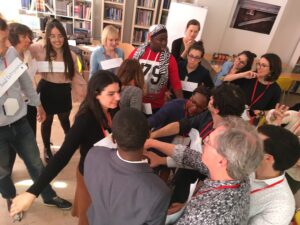Introduction
One of the most rewarding parts of my work over the years has been helping to create and nurture multi-stakeholder efforts. Multi-stakeholder initiatives are voluntary partnerships between groups (sometimes crossing different sectors – governments, civil society, the private sector and academia) to address complex challenges collaboratively through an organized and long-term agreement (formal or informal). Multi-stakeholder initiatives have existed for many decades but they have changed form and prominence over the years. They are now a major theme of many discussions around impact and seen as an important way of accomplishing what has often been stymied by a system which has rewarded the prominence of individual organizations and encouraged competition among them.
A short history
In the 1980’s we hadn’t yet labeled it a ‘multi-stakeholder initiative’ but there is something very logical in thinking about what you can accomplish in collaboration. During this period I was working as the executive director of the Council of Great Lakes Governors and we were exploring ways to sustain a commitment to great lakes water quality. We brought together a diverse, committed group, from government, business, academia and the nonprofit sectors. We spent months brainstorming a number of different ideas and then working together over a period of years, finally resulting in the Great Lakes Protection Fund, a regional endowment. (Although they were not yet members, we also consulted with the Canadian Premiers of the provinces bordering the lakes and years later they became full members of the council.)
By the 2000’s it was easier to create global multi-stakeholder collaborations. In the mid-2000’s the American Academy of Pediatrics was looking to identify partners who could help birth attendants around the world to use a technique American pediatricians were using to keep babies safer at birth, and which had spread around the world informally as pediatricians traveled and met with their colleagues. Through a series of conversations with a wide range of potential partners in the government, business and nonprofit sectors a formal global alliance was developed: Helping Babies Breathe (later Helping Babies Survive and Thrive). In doing some research for the initiative, I also discovered other existing global collaboratives such as the Sustainable Food Lab.
As the 2000’s progressed we saw more multi-stakeholder initiatives, many of them having a broader reach and more sophisticated infrastructure such as GAVI the Global Alliance for Vaccine Immunization. GAVI was started by the World Health Organization, UNICEF, the World Bank and the Bill & Melinda Gates Foundation and now has a wide range of country and civil society organization partners around the world. The Scaling Up Nutrition (SUN) Movement was launched in 2010 to include partners in business, international donors and civil society organizations united to fight malnutrition. Several other examples are included in the lessons learned section below.
Different types of structures and ways of operating
When starting or nurturing your own multi-stakeholder initiative, it is useful to note that there are different structures, more and less formal, and with different timeframes. Some are designed to last for shorter, well-defined periods of time and have volunteer organizations support the collective work, while others intend to last for significant periods of time and have more formal secretariat staffing and steering groups. Your structure can be customized depending on what will work best for your goals and collaboration partners.
The following lessons come from these multi-stakeholder initiatives
Reproductive Health Supplies Coalition
- Based on articulated shared goals, keep the focus on collaborative actions and what each member brings and values. Regular member check-ins can be helpful to maintaining member commitment.
- Have (and use) clear objectives to keep from being pulled in too many different directions.
- There may be tensions between formalizing and being flexible, and between member and donor interests, and these will need balancing.
- Working groups can go in cycles with changes in leadership, timing, etc.. Some groups have scaled back the number of their working groups.
- Rotating the annual meeting around the world can provide an opportunity for groups to bring in members from different geographic locations.
- Evidence (such as the impact of nutrition on health) can be very important to sustaining commitment.
- Keep recalibrating the way you do things – ask is this still effective?
- Although finding funding can be an ongoing challenge, adequate secretariat capacity is very important for sustaining momentum.
- “Collaborative work can be difficult, but it’s how things get done.”
Additional Resources
